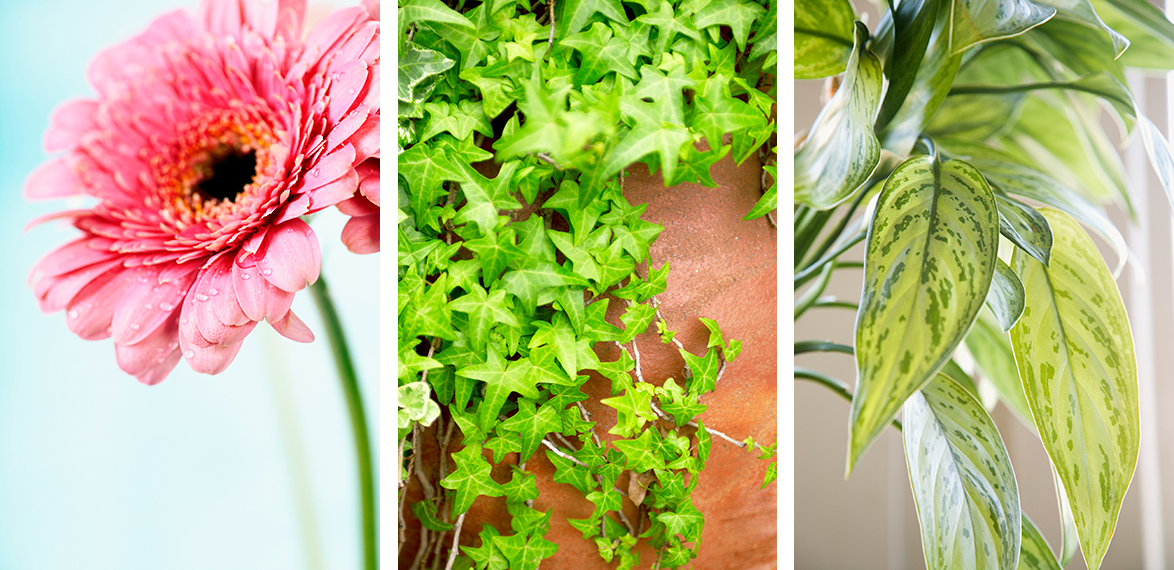At Home
Plants for Cleaning the Air
Indoor air pollution in the house, condo, confined office area or school is well known. Which indoor plants are the most effective for your environment? Each indoor plant has its light requirement, and this must be a considered when purchasing the appropriate plant. Plants have the necessary job to remove air pollutants (gases), such as benzene, trichloroethylene, and formaldehyde. When you introduce greenery to your indoor space you are benefiting your health and mind. The award-winning scientist, Bill C. Wolverton said, “Nature has built into plants the ability to use our waste for their nourishments.”
Plants absorb carbon dioxide and release oxygen. By adding plants, you are increasing the oxygen levels in your interior space – breathing becomes easier.
Plants release roughly 97 per cent of the water they take in which will increase the humidity around you. The chance of colds, sore throats, dry coughs, and other respiratory ailments are decreased. Before you purchase a humidifier machine to soften the air, consider buying a plant or two.
Air is purified as plants remove the toxins from the air. We breathe the same air again and again, and there is the potential of inhaling harmful substances that are trapped indoors. Indoor plants help to remove pollutants including volatile organic compounds (VOCs) that can cause headaches, nausea, and more aliments. In addition to filtering unwelcome chemicals, plants also emit clean air, improving the air quality surrounding them.
In the 1980s, NASA conducted a study to determine which plants were best able to filter the air of the space station. NASA’s research confirmed that living, green and flowering plants could remove several toxic chemicals from the air in building interiors. Of all the plants, NASA deemed the spider plant to be the bestindoor plant for ‘scrubbing’ indoor air pollution. The following selection of air-purifying plants is based on the NASA study.
| Common Name (Cultivar) | Botanical/Scientific Name | Exposure | Benefit | OPALS® Allergen Ranking |
| African/Gerbera daisy | Gerbera jamesonii | Medium/high light | Releases oxygen at night; purifies air by removing benzene and trichloroethylene | 5 |
| Chinese evergreen (toxic to cats) | Aglaonema aracea | Medium light | Purifies air; removes formaldehyde from the air | 5 |
| English ivy (Toxic to cats) | Hedera helix | Bright indirect light | Removes benzene from the air | 7 |
| Madagascar dragon tree(toxic to cats) | Dracaena marginata | Low light | Purifies air; removes formaldehyde, benzene, toluene and xylene from the air | 4 – 6, depending on species |
| Peace lily (toxic to cats | Spathiphyllum araceae | Low light | Removes mould from the air | 2 |
| Reed/bamboo palm | Chamaedorea seifirizii | Bright light | Purifies air; removes formaldehyde from the air | m = 7 – f = 1 |
| Spider plant | Chlorophytum comosum | Low light | Purifies air rapidly; removes formaldehyde; doesn’t like tap water because of chorine | m = 6 – f = 1 |
| Variegated snake plant (toxic to cats) | Sanseviera trifasciata | Low light | Purifies air; removes formaldehyde and nitrogen oxide | 1 |
Legend:
According to OPALS® ranking: 1 = low (allergy friendly) and 10 = high, very allergenic.
Let’s Talk about Light
To achieve ultimate success in growing indoor plants, careful planning is required to expose them to the optimum light level for their species.
Bright light loving plants need to receive at least 5 hours of direct sunlight per day, usually a south or west-facing window.
Indirect light loving plants need at least 61 cm (2 feet) from a south-facing window or for the window to have a sheer curtain to filter the light.
Low light loving plants flourish with little attention from you. They also require very little light to flower. Plants can be placed in east or north facing windows, foyers, stair landings or anywhere that doesn’t get direct sunlight.
Medium-light loving plants that grow in medium light are a low fuss plant. They can tolerate some direct light, but not a lot. They like light, so bright light is good, but not direct light. They’re good to go near a west or south-east window.
High light loving plants need a lot of light (high light) to do their best. Place them in south or west windows locations that get direct light most of the day. Windows that face south receive the most direct sunlight and are often too bright and hot for most indoor plants. Look at achieving indirect light when needed.










